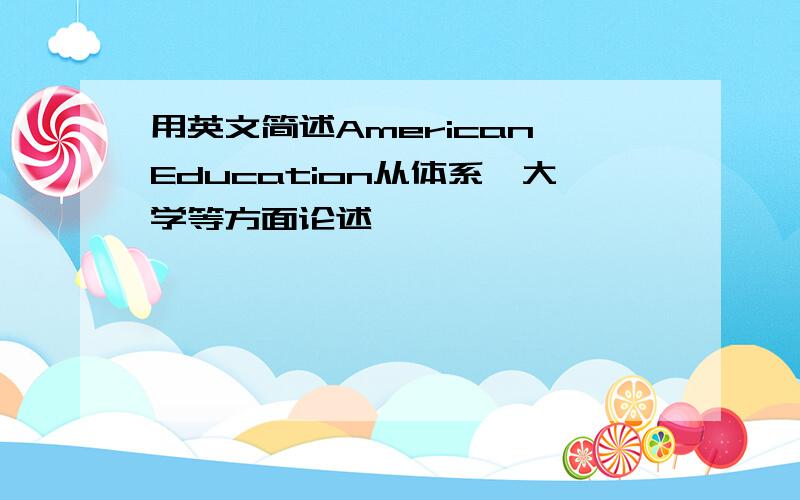用英文简述American Education从体系、大学等方面论述
来源:学生作业帮助网 编辑:作业帮 时间:2024/04/27 11:46:13

用英文简述American Education从体系、大学等方面论述
用英文简述American Education
从体系、大学等方面论述
用英文简述American Education从体系、大学等方面论述
American education offers a rich field of choices for the international student. From abroad, and even from within the U.S.A., there is such an array of institutions, programs and locations that the choices may overwhelm the student. To simplify the choices, a student must carefully study how each program and location can fulfill the student's goals. In order to make informed decisions, a student will need to know how the U.S. education system is organized.
Primary and Secondary School: Begins around age six for U.S. children. They attend five or six years of primary school. Next they go to secondary school, which consists of either two three- year programs or a three-year and a four-year program. These are called "middle school" or "junior high school" and "senior high school" (often just called "high school"). Americans call these twelve years of primary and secondary school the first through twelfth "grades."
Higher Education: After finishing high school (twelfth grade), U.S. students may go on to college or university. College or university study is known as "higher education." You should find out which level of education in your country corresponds to the twelfth grade in the U.S.A. You also should ask your educational advisor or guidance counselor whether you must spend an extra year or two preparing for U.S. admission. In some countries, employers and the government do not recognize a U.S. education if a student entered a U.S. college or university before he or she could enter university at home.
Study at a college or university leading to the Bachelor's Degree is known as "undergraduate" education. Study beyond the Bachelor's Degree is known as "graduate" school, or "postgraduate" education. Advanced or graduate degrees include law, medicine, the M.B.A., and the Ph.D. (doctorate).
Where you can get a U.S. higher education
1. State College or University: A state school is supported and run by a state or local government. Each of the 50 U.S. states operates at least one state university and possibly several state colleges. Some state schools have the word "State" in their names.
2. Private College or University: These schools are operated privately, not by a branch of the government. Tuition will usually be higher than at state schools. Often, private colleges and universities are smaller in size than state schools.
3. Two-Year College: A two-year college admits high school graduates and awards an Associate's Degree. Some two-year colleges are state-supported, or public; others are private. You should find out if the Associate's Degree will qualify you for a job in your country. In some countries, students need a Bachelor's Degree to get a good job. Two-year college or "junior" college graduates usually transfer to four-year colleges or universities, where they complete the Bachelor's Degree in two or more additional years.
4. Community College: This is a two-year state, or public college. Community colleges serve a local community, usually a city or county. Many of the students are commuters who live at home, or evening students who work during the day. Often, community colleges welcome international students. Many of these schools offer special services to international students such as free tutoring. Many community colleges also offer ESL or intensive English programs.
Some community colleges provide housing and advising services that an international student might need. Again, find out if a community college degree will be enough for you to get a job when you return home. Most, but not all governments, recognize degrees from junior and community colleges.
5. Professional School: A professional school trains students in fields such as art, music, engineering, business, and other professions. Some are part of universities. Others are separate schools. Some offer graduate degrees.
6. Institute of Technology: This is a school which offers at least four years of study in science and technology. Some institutes of technology have graduate programs. Others offer shorter courses.
7. Technical Institute: A technical institute trains students in fields such as medical technology or industrial engineering. Although the course may prepare you for the career you want, the degree may or may not be equivalent to a college or university degree. Some colleges and universities do not accept credits from students who have attended technical institutes and want to transfer. If you are considering a technical institute, find out if your government, and U.S. colleges and universities, accept the school's degree.
8. Church-related School: Many U.S. colleges and universities were founded by religious groups. The relationship, however, between the school and the religious organization may be very flexible. Sometimes, these schools prefer to admit students who are members of the sponsoring religious group. Nearly all these schools welcome students of all religions and beliefs.
Traditionally, many church-related schools have required that students take Bible courses and attend chapel services. But these practices are becoming less common.
Undergraduate (College) Years
Course of study: U.S. students usually study a wide variety of subjects while in college. Many students do not specialize exclusively in one field until graduate school.
The first two years of college are called the "freshman" and "sophomore" years. Students in the first year are called "freshmen," and they are "sophomores" in the second year. Some schools require freshmen and sophomores to take courses in different areas of learning: literature, science, the social sciences, the arts, history, and so forth. Freshmen and sophomores are known as "underclassmen."